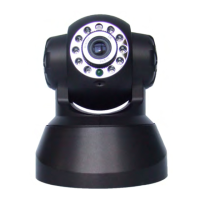
Do you have a question about the Kingstar CoolCam and is the answer not in the manual?
| Brand | Kingstar |
|---|---|
| Model | CoolCam |
| Category | Security Camera |
| Language | English |
Essential safety precautions and guidelines to follow before installing the camera.
Recommended environmental conditions for optimal camera placement and operation.
Guidelines for safely handling and transporting the camera device.
Procedures for cleaning, protecting, and maintaining the camera's condition.
List of all components and accessories included with the camera package.
Highlights the camera's core functionalities, sensors, and connectivity options.
Provides the physical measurements of the camera unit.
Overview of the quick setup guide and its purpose for the camera.
Step-by-step instructions for physically connecting the camera and its accessories.
Guide for installing the essential CoolCam camera management software.
Instructions on launching and interacting with the camera control software.
Steps for configuring the camera to operate within your local network.
Explanation of ActiveX controls and their importance for full camera functionality.
Overview of the user interface controls for basic camera operation.
Instructions on using directional controls to move the camera's view.
How to set up and use automated camera movement sequences.
Guide to saving and recalling specific camera positions for quick access.
Adjusting video display resolution and refresh rate (Hz) for optimal viewing.
Fine-tuning the camera's image clarity and contrast.
Procedure to revert all camera settings back to their factory defaults.
Accessing features for monitoring, recording video, and audio streams.
Simultaneously viewing feeds from multiple connected cameras.
Enabling date and time overlays on recorded video for accurate tracking.
Customizing camera name, date, and time display on the video feed.
Adjusting audio buffer size to manage sound delays on slow networks.
Managing the live video feed (play/pause) and capturing still images.
Instructions on initiating and managing video and audio recording.
Configuring network parameters required for internet connectivity.
Setting IP address, subnet mask, and gateway via Administrator tab.
Enabling Universal Plug and Play for automatic port mapping.
Instructions on how to connect to the camera's web interface using its assigned URL.
Accessing and managing the camera's comprehensive administrative options.
Viewing essential hardware and software details of the camera.
Assigning custom names to cameras for easier network identification.
Setting the camera's timezone and synchronizing its clock with NTP servers.
Creating and managing user accounts with specific access privileges.
Configuring and managing multiple connected CoolCam cameras.
Manual or DHCP configuration of network IP and port details.
Configuring the camera to connect to a Wi-Fi network.
Steps for establishing a wireless connection for the camera.
Setting up camera integration with Windows Live Messenger for alerts.
Using chat commands to retrieve the camera's URL.
Setting up Dynamic DNS for remote access using a domain name.
Configuring email notifications for motion detection and alarms.
Setting the email address from which alert notifications are sent.
Specifying the email addresses that will receive alerts.
Entering SMTP server details for sending emails.
Setting up FTP for remote uploading of images upon motion detection.
Verifying the FTP server configuration and connection.
Configuring motion detection, alarms, and alert triggers.
Enabling and activating the camera's motion detection feature.
Adjusting the sensitivity level for accurate motion detection.
Setting up and arming external alarm input signals.
Linking alarm events to input/output hardware for automated actions.
Detailed instructions for connecting and configuring external I/O devices.
Enabling email alerts to be sent when an alarm condition is met.
Configuring the camera to upload images automatically when an alarm triggers.
Adjusting Pan, Tilt, and Zoom (PTZ) movement presets and speeds.
Procedure for updating the camera's firmware for new features and fixes.
Saving current configurations and restoring them later.
Resetting the camera to its original default configuration.
Instructions for restarting the camera device.
Connecting to the camera using browsers like Firefox, Chrome, or Safari.
Overview of the interface and limited features available in alternative browsers.
Connecting to the camera using web browsers on mobile devices.
Interface overview and available controls when accessing via mobile.
Steps to reset forgotten administrator username and password.
Troubleshooting missing shortcuts for the camera software.
Guidance on resolving issues related to setting up the camera's IP address.
How to resolve 'Subnet does not match' errors in the camera tool.
Troubleshooting common problems preventing access via web browser.
Resolving issues with ActiveX controls required for camera features.
Diagnosing and fixing performance issues like jerky video or slow controls.
Addressing 'Failed to connect to the device' prompts, often with multiple cameras.
Comprehensive guide for resolving problems accessing the camera over the internet.
Solutions for when the camera software fails to detect the device.
Final troubleshooting step: resetting the camera to factory defaults.
Definitions of common technical terms used throughout the manual.
Essential steps for configuring network routers to enable camera access.
Detailed steps for configuring IP and network settings via the camera tool.
Setting up custom services or virtual servers on the router for the camera.
Configuring router firewall rules to permit camera network traffic.
Setting up outbound firewall rules to allow camera network communication.
General advice and resources for setting up port forwarding on routers.
Alternative methods for Mac users to access the camera locally.
Using IP Scanner software to find the camera's local IP address on Mac.
Steps to locate the camera's IP address by checking the router's connected devices.